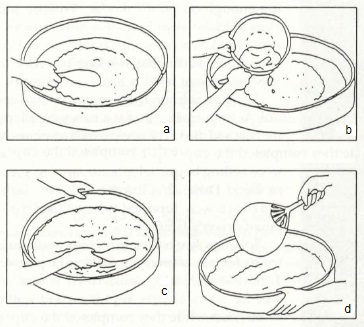by Kanami Egami
Aushi made with katsuo is a favorite with fisherman, prepared and enjoyed on the beach. Why not try it as an accompaniment to your barbecue this summer.
Ingredients:
(a) 250g bonito; 3T soy; sauce 2t sugar
(b) 2 cups rice; 10 x 10 cm. kobu seaweed (kelp); 2T mirin; 2T sake; 2 cups water
(c) 3T vinegar; 1 1/3t salt; 5 shiso leaves; 10g ginger
1T white sesame seeds
1/2 sheet Asakusa-nori (dried seaweed)
Cooking method:
(1) Wash and drain the rice one hour before cooking.
(2) Place rice in a heavy bottomed, medium sized pan or rice cooker and add 870cc of water, 4T sake and 2T mirin and kelp.
Cover and bring to the boil over medium heat. When it reaches boiling point, discard kelp, remove from heat and leave for 3 minutes. Bring to the boil again over a medium heat, then simmer for approximately 20 minutes until the rice has absorbed almost all the water. Then turn the heat high for a few seconds. Remove from heat, still covered, and let stand for 10 minutes.
(3) Vinegar dressing (c): Dissolve salt and sugar in vinegar.
Sprinkle the dressing over rice. Using a flat wooden spoon, spread the hot rice in a thin layer in a wide, non-metallic dish or tray, preferably made of wood. To keep the grain separate, toss rice with horizontal, cutting strokes. This lateral motion will also prevent grains from being bruised. At the same time as you are tossing the rice, cool quickly and thoroughly with a fan (uchiwa).
The tossing and fanning takes about 10 minutes. Taste to see whether the rice is at room temperature.
(See picture above)
a, b. Pour on vinegar mixture as you spread rice.
c. Use only a horizontal cutting motion when mixing and tossing sushi rice.
d. Cool rice with fan as you toss it.
To keep vinegared rice from drying out when it has cooled to room temperature, place in a container and cover with a damp cloth. Vinegared rice should be eaten the same day it is prepared; it does not keep for more than one day. It should not be refrigerated. Any leftovers, unfortunately, cannot be stir-fried Chinese-style to make fried rice.
(4) Cut bonito fillets into 2-3 lengthwise. Slice each bonito into 5mm thin slices. Marinate in (a) for 15-20 minutes.
(5) Cut shiso and ginger into thin strips. Leave in water for 5 minutes and drain.
(6) Roast white sesame seeds and chop. Cut Asakusa-mori into 4cm length thin strips.
(7) Mix shiso, white sesame seeds and ginger with rice using your fingers. Add bonito and mix gently.
(8) Place (7) on a plate and sprinkle with Asakusa-nori seaweed.
Footnotes on katsuo or bonito:
(1) Katsuo (bonito or skipjack tuna) is one of the most important species of fish used in Japanese cooking.
Familiar dried fillets, katsuo-bushi, may look like driftwood, but when shaved into thin flake, it becomes the basic soup stock for all Japanese cooking.
Fresh bonito, caught in May and eaten raw as sashimi (called tataki) is popular among Japanese as hatsu-gatsuo, meaning the first fish of the season. For more than 700 years, this spring hatsu-gatsuo has been considered a great delicacy and its appearance is a symbol of spring.
However, fresh bonito caught in autumn are bigger and richer in fat than those caught in spring.
(2) Good fresh bonito is almost round in the cross-section, tapered at each end and has shiny white stripes on its lower sides. Shiny red flesh and a springy touch indicate they are fresh and of good quality.









